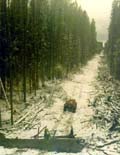Arin MacFarlane
Graduate Student
Arin MacFarlane
BSc Univeristy of Alberta, 2000
Honors project examined reforestation of seismic lines in Alberta's boreal forest.
Currently in MSc program expected to finish fall 2002.
Current Research:
Modelling of the impacts of seismic lines in the boreal forest has indicated that increased activity of the oil and gas in conjunction with the forestry industry will have negative effects on harvest sustainability and may degrade the boreal ecosystem as a whole (Stelfox 2000). In Alpac's FMA seismic lines alone nearly double the amount of land logged each year(Alberta Environmental Protection 1998; Stelfox 2000). These linear features have been shown to poorly regenerate over time (Revel et al. 1984; Alpac unpublished data) thereby contributing to fragmentation and reductions in forested landbase. In addition, seismic lines may be subject to edge effects that alter the amount of timber lost and that change landscape structure and species composition.

The first objective of this study is to evaluate the extent that seismic lines change the structure and composition of edge communities. To accomplish this, the relative amount and species composition of standing edge trees, snags and DWM will be measured and compared to interior forest. Understory shrub and herbaceous species compositions will be recorded on-line and on the edge and compared to interior forest. Special attention will be paid to weedy or exotic species on-line and penetrating the forest.
![]()
The second objective is to understand how edge effects on seismic lines influence timber supply. In addition to initial tree removal volume loss may be increased due to edge tree mortality. However, some volume loss may also be recovered by on-line and adjacent stand recruitment as well as edge tree radial growth. This study will also attempt to determine the relative differences in volume loss, over time, between young and merchantable aged stands.
![]()
Seismic lines can be created in such a way as to prevent long term damage to the vegetation on-line and to prevent any impact on surrounding forests. Therefore, the potential of 5m wide, curved, low impact lines (LIS)to mitigate on-line and line-edge impacts will be compared to those impacts on conventional lines. Overall, any significant divergence from interior forest on both line types will be related to consequences for Alberta's boreal landscape dynamics and sustainable timber harvest using the modelling program ALCES.
|
Last Modified:2002-08-15 |